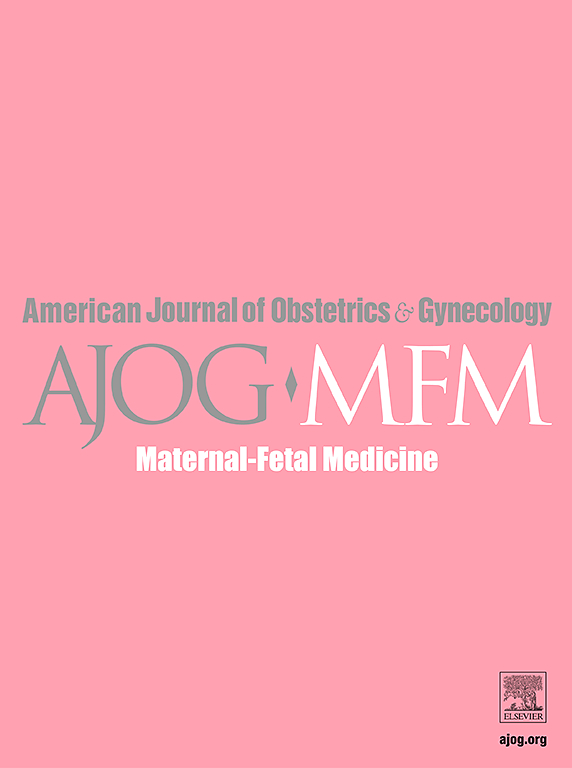Randomized controlled trial of the impact of ursodeoxycholic acid on glycemia in gestational diabetes mellitus: the GUARDS trial
IF 3.1
2区 医学
Q1 OBSTETRICS & GYNECOLOGY
American Journal of Obstetrics & Gynecology Mfm
Pub Date : 2025-07-09
DOI:10.1016/j.ajogmf.2025.101732
引用次数: 0
Abstract
BACKGROUND
Gestational diabetes mellitus is a pregnancy complication that can be associated with increased risks of adverse maternal and neonatal outcomes. Optimal glycemic control remains challenging for many patients despite the existing management strategies. Ursodeoxycholic acid is commonly used for cholestasis of pregnancy and has shown potential metabolic benefits, including improved insulin sensitivity and reduced inflammation. We hypothesize that ursodeoxycholic acid may improve glycemic control in gestational diabetes mellitus.
OBJECTIVE
This study aimed to compare treatment with ursodeoxycholic acid vs placebo for improving maternal glycemia in gestational diabetes mellitus.
STUDY DESIGN
This was a single-site, randomized, double-blind, placebo-controlled trial of ursodeoxycholic acid in 113 women with gestational diabetes mellitus at 24 to 28 weeks’ gestation. The primary outcome was maternal fasting blood glucose concentration at 35+0 to 37+6 weeks’ gestation.
RESULTS
The primary outcome did not differ significantly between groups when evaluated by intention to treat analysis (treatment effect, 0.98; 95% confidence interval, 0.92–1.05; P=.61). There were no differences in maternal or fetal secondary outcomes, including maternal weight change, need for insulin treatment, birthweight centile, proportion of large or small for gestational age infants, neonatal hypoglycemia, or admission to the neonatal unit. A prespecified secondary analysis measured serum concentrations of ursodeoxycholic acid using ultra-performance liquid chromatography–tandem mass spectrometry and showed that participants taking larger numbers of tablets had higher serum concentrations of ursodeoxycholic acid. Post hoc analysis revealed no difference in the rate of fasting blood glucose concentrations at or above the recommended target of 90 mg/dL according to intention to treat analysis (5/50 [10.0%] vs 8/53 [15.1%]; risk ratio, 0.66; 95% confidence interval, 0.23–1.89; P=.557). However, among patients with serum ursodeoxycholic acid ≥0.5 µmol/L (indicating adherence), fewer patients had fasting glucose levels above the target (2/42 [4.8%] vs 11/57 [19.3%]; risk ratio, 0.25; 95% confidence interval, 0.06–1.06; P=.039).
CONCLUSION
This trial demonstrated no difference in fasting glycemia between women with gestational diabetes mellitus treated with ursodeoxycholic acid and those treated with placebo. However, those with elevated serum ursodeoxycholic acid concentrations were more likely to have fasting blood glucose concentrations below the recommended thresholds, suggesting potential benefit of further investigation.
熊去氧胆酸对妊娠期糖尿病患者血糖影响的随机对照试验:卫兵试验。
背景:妊娠期糖尿病(GDM)是一种妊娠并发症,可增加孕产妇和新生儿不良结局的风险。尽管有现有的管理策略,但对许多患者来说,最佳血糖控制仍然具有挑战性。熊去氧胆酸(UDCA)通常用于妊娠期的胆汁淤积,并显示出潜在的代谢益处,包括改善胰岛素敏感性和减少炎症。我们假设UDCA可能改善GDM患者的血糖控制。目的:比较熊去氧胆酸(UDCA)与安慰剂治疗对改善GDM孕妇血糖的作用。研究设计:在113名妊娠24-28周的GDM妇女中进行UDCA单点、随机、双盲、安慰剂对照试验。主要终点为妊娠35+0-37+6周时的孕妇空腹血糖浓度。结果:以治疗意向评估时,两组间主要结局无显著差异(治疗效果0.98 (95% CI 0.92 ~ 1.05, p=0.61));产妇和胎儿的次要结局没有差异,包括产妇体重变化、胰岛素治疗需求、出生体重百分位数、大或小胎龄婴儿的比例、新生儿低血糖或入住新生儿病房。预先指定的二次分析使用UPLC-MS/MS测量了UDCA的血清浓度,结果显示服用较多药片的参与者血清中UDCA浓度较高。事后分析显示,根据治疗意向,空腹血糖浓度达到或高于推荐目标90mg/dL的比率无差异(5/50(10.0%)对8/53 (15.1%),RR 0.66, 95% CI 0.23至1.89,p=0.557)。然而,在血清UDCA≥0.5µmol/L的患者中,与服用UDCA一致,空腹血糖高于目标的患者较少(2/42(4.8%)对11/57 (19.3%),RR为0.25,95% CI为0.06至1.06,p=0.039)。结论:该试验表明,与安慰剂相比,UDCA治疗的GDM女性的空腹血糖没有差异。然而,血清UDCA浓度升高的患者更有可能空腹血糖浓度低于推荐阈值,这表明进一步研究的潜在益处。
本文章由计算机程序翻译,如有差异,请以英文原文为准。
求助全文
约1分钟内获得全文
求助全文
来源期刊

American Journal of Obstetrics & Gynecology Mfm
Medicine-Medicine (all)
CiteScore
7.40
自引率
3.20%
发文量
254
审稿时长
40 days
期刊介绍:
The American Journal of Obstetrics and Gynecology (AJOG) is a highly esteemed publication with two companion titles. One of these is the American Journal of Obstetrics and Gynecology Maternal-Fetal Medicine (AJOG MFM), which is dedicated to the latest research in the field of maternal-fetal medicine, specifically concerning high-risk pregnancies. The journal encompasses a wide range of topics, including:
Maternal Complications: It addresses significant studies that have the potential to change clinical practice regarding complications faced by pregnant women.
Fetal Complications: The journal covers prenatal diagnosis, ultrasound, and genetic issues related to the fetus, providing insights into the management and care of fetal health.
Prenatal Care: It discusses the best practices in prenatal care to ensure the health and well-being of both the mother and the unborn child.
Intrapartum Care: It provides guidance on the care provided during the childbirth process, which is critical for the safety of both mother and baby.
Postpartum Issues: The journal also tackles issues that arise after childbirth, focusing on the postpartum period and its implications for maternal health. AJOG MFM serves as a reliable forum for peer-reviewed research, with a preference for randomized trials and meta-analyses. The goal is to equip researchers and clinicians with the most current information and evidence-based strategies to effectively manage high-risk pregnancies and to provide the best possible care for mothers and their unborn children.
 求助内容:
求助内容: 应助结果提醒方式:
应助结果提醒方式:


